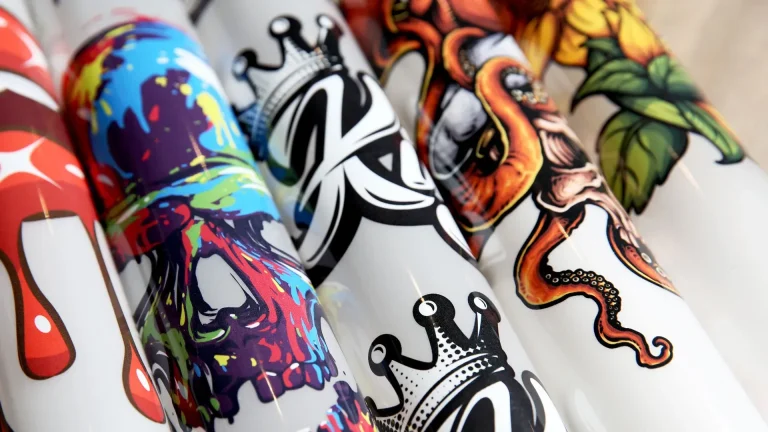DTF transfers, or Direct-to-Film transfers, represent a groundbreaking advancement in custom apparel design, revolutionizing the way fashion creators bring their artistic visions to life. As the demand for unique, vibrant designs continues to grow in the apparel market, DTF printing stands out for its ability to deliver stunning colors and intricate details with remarkable durability. This innovative printing technology not only enhances the design potential by enabling a high degree of customization but also aligns perfectly with modern consumer trends that favor personalized fashion. With the versatility to adapt to various fabric types, DTF transfers open up limitless possibilities for designers seeking to create standout pieces. In this article, we will explore how perfectly sized DTF transfers can elevate your creations, ensuring they make a lasting impression in the competitive world of fashion.
Direct-to-Film printing has emerged as a pioneering technique in the realm of garment decoration, making it an invaluable tool for those in the custom apparel industry. This method allows for the seamless transfer of detailed graphics onto diverse textiles, providing an exciting venue for creativity among fashion designers. With its focus on producing eye-catching and resilient prints, DTF technology is redefining the landscape of personalized clothing. From vibrant hues to intricate designs, the opportunities presented by this printing process are as varied as the fabrics themselves. As we delve into the nuances of DTF transfer sizing, discover how mastering this technique can significantly enhance your design outcomes.
Understanding DTF Printing Technology
Direct-to-Film (DTF) printing technology has revolutionized the way designs are transferred onto various fabric types. This innovative method involves printing high-quality graphics on a specialized film, which is then bonded to fabric using heat and pressure. Unlike traditional methods, DTF allows for vibrant colors and intricate details, making it ideal for custom apparel designs. The ability to print on diverse textiles without compromising image integrity has made DTF a popular choice among fashion designers and small businesses alike.
Moreover, advancements in DTF printing have led to improved printer capabilities, allowing for even finer resolution and color accuracy in prints. This technology caters to various markets, from basic apparel to premium collections, ensuring designers can explore their creativity without limitations. As a result, understanding DTF printing technology is essential for anyone looking to maximize their design potential in today’s competitive landscape.
The Role of Size in DTF Transfers
Size plays a crucial role in the effectiveness of DTF transfers. A well-sized transfer not only enhances the overall aesthetic of the garment but also ensures that the design adheres properly without any defects. When the sizing is off, it can lead to distorted images or unnecessary stretching, which can ultimately hurt a brand’s reputation. Proper sizing allows designs to be visually striking while remaining functional, ensuring longevity in both wear and appearance.
Additionally, the flexibility of DTF printing allows designers to tailor sizes to suit specific garment types. This adaptability is vital for creating unique styles that cater to different customer preferences, enhancing the overall appeal of custom apparel. By prioritizing size accuracy during the design and printing process, creators can maximize their capabilities and deliver exceptional products that resonate with consumers.
Recent Developments in DTF Printing
The DTF printing industry is continuously evolving, with recent developments significantly impacting how designers approach their work. For instance, the introduction of high-quality printers has elevated the standards of print resolution and vibrancy. This enhancement allows for the recreation of detailed graphics that showcase intricate designs while maintaining size integrity, ensuring that every aspect of the design is highlighted to its full potential.
Moreover, the rise of eco-friendly practices within the DTF printing sector cannot be overlooked. As consumers become more environmentally conscious, brands are responding by integrating sustainable materials and processes into their workflows. Utilizing eco-friendly inks and films not only adds value to the products but also aligns with consumer expectations, making the designs more appealing in a saturated market.
Exploring Material Variability in DTF Transfers
Choosing the right materials is essential for achieving optimal results with DTF transfers. Each fabric type can behave differently under the DTF process, affecting the overall quality and vibrancy of the print. Designers are encouraged to experiment with an array of fabrics to discover which combinations yield the best results, whether it’s cottonly t-shirts, polyester blends, or other unique textiles.
By understanding the nuances of each material, designers can maximize their design potential, ensuring vibrant colors and durability in their prints. This knowledge not only benefits the immediate design but also enhances a brand’s reputation as a reliable source for quality custom apparel. Exploring various materials can lead to innovative product offerings and novel design concepts that set a brand apart.
The Benefits of High-Quality Equipment in DTF Printing
Investing in high-quality printing equipment is critical for any business looking to excel in DTF printing. Quality printers offer enhanced precision and accuracy, which are essential for producing perfectly sized transfers. By prioritizing quality, designers can ensure that their prints not only look professional but also meet customer expectations regarding durability and vibrancy.
Additionally, advanced equipment often includes features that streamline the printing process, reducing setup time and minimizing errors. This efficiency allows businesses to handle larger orders and cater to various clientele, making them more competitive within the market. Ultimately, the right equipment paves the way for successful project outcomes and satisfied customers.
Leveraging DTF Technology for Business Growth
Embracing DTF technology offers substantial growth opportunities for businesses in the custom apparel industry. The versatility of DTF printing allows companies to cater to a wide range of applications, from promotional merchandise to bespoke fashion pieces, enabling them to attract diverse customer segments. Furthermore, as consumer demand for customization continues to rise, businesses that effectively leverage DTF technology can establish themselves as leaders in the market.
Moreover, the adoption of DTF methods can significantly reduce production costs compared to traditional printing techniques. The lower setup costs and the ability to print on-demand make it easier for businesses to minimize waste and quickly adapt to changing market trends. By mastering DTF printing, companies can enhance their operational efficiency and innovate their product offerings, positioning themselves for long-term success.
Frequently Asked Questions
What are DTF transfers and how do they work?
DTF transfers, or Direct-to-Film transfers, are an advanced printing method where designs are printed directly onto a special film before being transferred onto textiles. The process involves printing your design, applying adhesive powder, and using a heat press to adhere the image to various fabrics, ensuring vibrant colors and detailed graphics.
Why is sizing important in DTF printing for custom apparel?
Sizing is crucial in DTF printing as it ensures that the design perfectly fits the garment. Incorrect sizes can lead to distorted images or designs that either appear too small or overpower the garment. Proper sizing enhances both the visual appeal and durability of the print, reducing issues like cracking or peeling.
Can DTF transfers be used on different types of fabrics?
Yes, DTF transfers are highly versatile and can be applied to various fabric types, including cotton, polyester, and blends. This adaptability allows designers to maintain vibrant colors and intricate details, making DTF printing ideal for an array of custom apparel.
What recent advancements are influencing DTF printing technology?
Recent advancements in DTF printing include the introduction of high-quality printers that improve print resolution and vibrancy. Additionally, there is a growing push towards eco-friendly options, with many manufacturers offering sustainable inks and films for DTF printing to appeal to environmentally conscious consumers.
How can designers maximize their design potential with DTF transfers?
Designers can maximize their potential with DTF transfers by investing in quality printing equipment, exploring different materials for compatibility, and ensuring precise sizing accuracy. By focusing on these areas, they can produce high-quality custom apparel that meets customer expectations.
What are some popular applications for DTF printing in the custom apparel industry?
DTF printing is popular among small and medium-sized businesses for a variety of applications, including promotional items, custom apparel for events, and specialized products tailored to niche markets. Its versatility and lower setup costs make it a preferred choice for creating unique and personalized merchandise.
| Key Component | Description |
|---|---|
| DTF Transfers | A printing method that transfers designs onto fabrics using a special film, resulting in vibrant and durable prints. |
| Precision | Proper sizing ensures designs fit well on garments without distortion, enhancing aesthetic appeal and durability. |
| Flexibility | Designers can create custom sizes for various garments, allowing for style adaptations and market trends. |
| Recent Trends | Advancements in high-quality printers and a shift towards eco-friendly options are shaping the DTF printing landscape. |
| Maximizing Design Potential | Invest in quality equipment, explore materials, and prioritize sizing accuracy for optimal results. |
| Industry Adoption | DTF technology is gaining traction among SMBs due to lower costs and versatility, making it ideal for customized apparel. |
Summary
DTF transfers represent a significant opportunity for fashion designers to enhance their creative output and production quality. By understanding and implementing the optimal sizes for DTF transfers, designers can ensure that their artwork translates perfectly onto garments, achieving both visual appeal and longevity. As businesses explore the potential of DTF printing, they can create customized products that resonate with consumers, capitalizing on trends in sustainability and technology. Thus, embracing DTF transfers not only boosts design flexibility but also aligns brands with modern needs, ultimately leading to increased customer satisfaction and success in the competitive custom apparel market.



